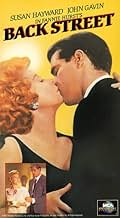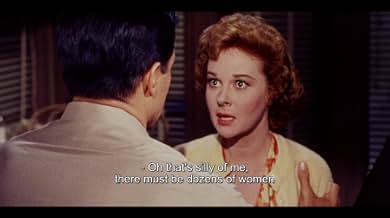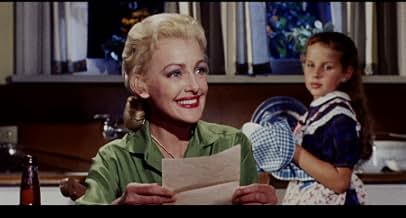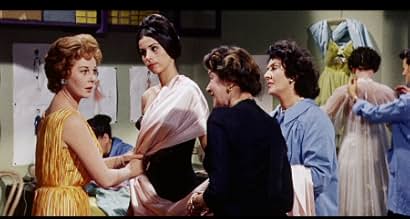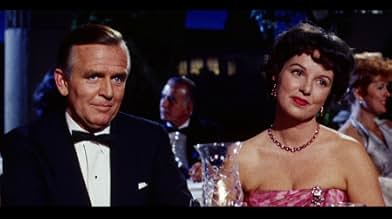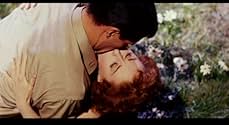NOTE IMDb
6,6/10
1,4 k
MA NOTE
L'histoire d'amour entre l'ambitieuse Rae Smith et l'élégant Paul Saxon débute au moment où celui-ci part à la guerre. Elle durera plusieurs années.L'histoire d'amour entre l'ambitieuse Rae Smith et l'élégant Paul Saxon débute au moment où celui-ci part à la guerre. Elle durera plusieurs années.L'histoire d'amour entre l'ambitieuse Rae Smith et l'élégant Paul Saxon débute au moment où celui-ci part à la guerre. Elle durera plusieurs années.
- Réalisation
- Scénario
- Casting principal
- Nommé pour 1 Oscar
- 1 nomination au total
Joseph Cronin
- Airport Clerk
- (as Joe Cronin)
Avis à la une
I have watched this film probably more than a dozen times and finally purchased the DVD even though it was only available in full TV-Sized screen format. It may be low brow and poor in most respects for a movie critic's standards, but I love it. I did not think either Hayward or Gavin did a bad or wooden job with their performances. Maybe I am just a patsy for tear-jerker style movies, but I have always enjoyed this movie, even today when it appears so dated and somewhat impoverished by today's standards of movie making. Perhaps we have become too jaded and so-called sophisticated to just sit back and appreciate a story that is reasonably well told and beautifully filmed.
When first released some forty years ago, critics rightly complained about the soap-opera plot, the melodramatic dialog, the stock characters, and the excessive showcasing of sets and costumes. These complaints are still valid, but over the course of four decades, a realization has emerged that despite or even because of these failings, "Back Street" is a gloriously entertaining work that plays just as well now as it did back in 1961. How many other movies can claim this sort of durability? I would, however, like to point out five faults in the production. (1) Susan Hayward is a good ten or even fifteen years too old for this part. (2) The film's supposed message about the emptiness of being the "other woman" is blunted by the opulent success in which Hayward lives. (3) Vera Miles' character is so selfish and shrewish that one can't imagine why John Gavin ever married her. There should have been a line about how he'd been forced into an "arranged" marriage in order to save the family business. (4) When Gavin and Hayward meet for the first time in New York, after their initial encounter in Nebraska, he seems surprised to learn that she's now the famous fashion-designer who signs her creations "rae" -- all small letters, very chic -- even though she'd specifically told him of her plans at their first meeting. How many fashion-designers named "rae" did he think there were in the world? (5) One must wait more than forty minutes before Gavin takes his shirt off, and then he just has a dimly-lit scene where he and Hayward run out of the ocean in modest swim-wear before reclining on a beach towel. Gavin's physique deserved much more exposure than this.
Wow....this is Susan Hayward and John Gavin at their best! If you must have an extra-marital affair...they show us how it's done!!! Real class, however, not without it's drawbacks, when children are involved. This will have you grabbing for the giant Kleenex box at the end. This version is a must have for you classic collectors,because it's much better than the old 1941 black & white. Fannie Hurst sure could write these teary classics, and it's too bad there aren't writers around like her anymore. You knew there was plenty of sex in this movie but it wasn't thrown in your face, and absolutely no profanity!!! Thank God, you don't even miss it... which makes it all the more intriguing!!
Watching this film is like having only cookies and ice cream for dinner. One feels guilt-ridden and knows he shouldn't have done it, but it was so good he's almost ready to do it again...and probably will! Producer Ross Hunter was at the helm so there aren't going to be any grey settings, uncombed hair or even a dirt smudge throughout. The film is a masterwork of overproduction and color coordination...the type of film that credits the furs and the oil paintings (!) in the titles. Hayward plays a single career woman in the mid-1940's who dreams of being a successful clothing designer. These early scenes have all the period detail of the 1940's as say...1958. On one eventful meeting with a potential backer, she collides with and instantaneously falls in love with Gavin, a marine just home from WWII. Who can blame her? He's a hunky dream come true and, for a certain amount of the film, he even has facial expression. His mating ritual includes bullying Hayward across a park lawn until she falls face first into a flower patch. From then on, she's hooked. Unfortunately, they are separated by a misunderstanding or two. Cut to years later (where Hayward, 11 years older than Gavin, looks younger and he now has grey in his hair!) which sees Hayward as a designer of dresses with "line" and style. Amusing support is provided by acerbic Gardiner as her mentor and Schafer (Mrs. Howell of "Gilligan's Island") as a gossipy client. The film globe trots to Paris, London, Rome (though, for some reason, a horrific Hayward body double does all the real travelling.) In one of the films many, MANY clichés and contrivances (Hayward even states at one point that, "All the clichés are true."), the former lovebirds are reunited over the fallen-down body of Gavin's wife Miles. Here, the film takes a powerful turn into the camp stratosphere as shrewy, boozy, slutty Miles (in a stunningly vivid performance) makes the pair's lives miserable. Miles is so intensely evil and vengeful that she becomes a sort of hilarious supervillain when compared with the rather saintly, drab lovers. Her histrionics are like manna from Heaven, no more so than when she makes a triumphant and highly memorable appearance at one of Hayward's fashion shows. Gavin also has two kids. One (Marihugh) is a pretty silent Shirley Temple wannabee. The other (Eyer) is a snotty, annoying child who was scarcely ever heard from again, he so irritated filmgoers. The "Back Street" of the title is SUPPOSED to refer to a secretive, undesirable place for the mistress to be kept away on. In Hunter's version, it's a completely charming cottage in the country! Gavin provides Hayward with the cottage's first piece of decor, but note how she moves it from it's original spot so that we can have a special fade out at the end. The comic book-level melodramatics of the film are emphasized right away by titles that show Lichtenstein-esque pictures of the star trio accompanied by a typically heart-tugging Frank Skinner score. In a spiteful move against the audience, Gavin is shown in clingy swim trunks, but only briefly, from the waist up and in a dimly lit scene! Hayward shows a lot of energy and conviction in her role. Her best scenes involve several pivotal telephone calls. Another note: Grey (a charming actress who plays Hayward's sister) is the same age in real life, yet looks like she could play Hayward's mother! Did she live hard or was she denied the star lighting that Hayward got?? Hunter considered her his good luck charm and cast her in nearly everything until "Lost Horizon". Big mistake to leave her out! That was a notorious flop.
Many of the past reviewers of BACK STREET make good points in their comments on the film, stressing its clichés, its contrivances, its lack of real sincerity and emotion. Although I can see these points here and there, I have been hooked to this film ever since I saw it as a teenager, in the early sixties. Does this attraction have to do with the story itself? For me it does, no matter how rehashed it may be. Does it have to do with the characters? Yes, no matter how trite and unoriginal they may be. Does it have to do with the actors? CERTAINLY, especially Susan Hayward, an actress I admire profoundly, who is capable of keeping my attention as few others can, and who always dazzles with with her technique and capacity to be true, no matter how trashy the material originally is. Of course, BACK STREET owes a lot to its production values, the cinematography, the sets and gowns, but the motive of my attraction lies somewhere else, and it must be deep in myself, an area that was already sensitive to the film's values when I first saw it as a boy of 13.
Le saviez-vous
- AnecdotesA clip of Rae saying goodbye to Paul the marine is featured at the beginning of Stevie Wonder's "Part-Time Lover" music video as a couple watches "Back Street" on TV.
- GaffesAfter Rae's confrontation with Paul's son, she drives out to the country house and turns off the paved road onto a dirt road. But, in the next shot, the rear-screen projection still shows the paved road.
- Citations
Paul Saxon: [presenting her with a framed portrait of himself] Do you think you can build a room around that?
Rae Smith: Why not? I've built a life around it.
- ConnexionsFeatured in The Universal Story (1996)
- Bandes originalesSymphony No. 4 in E minor I. Allegro non troppo
Composed by Johannes Brahms
Meilleurs choix
Connectez-vous pour évaluer et suivre la liste de favoris afin de recevoir des recommandations personnalisées
- How long is Back Street?Alimenté par Alexa
Détails
- Durée1 heure 47 minutes
- Rapport de forme
- 1.85 : 1
Contribuer à cette page
Suggérer une modification ou ajouter du contenu manquant

Lacune principale
By what name was Histoire d'un amour (1961) officially released in India in English?
Répondre
